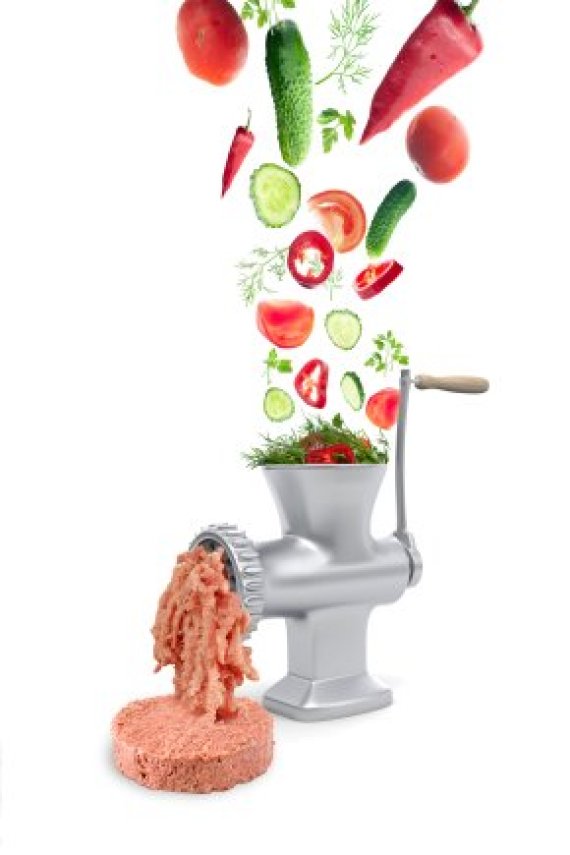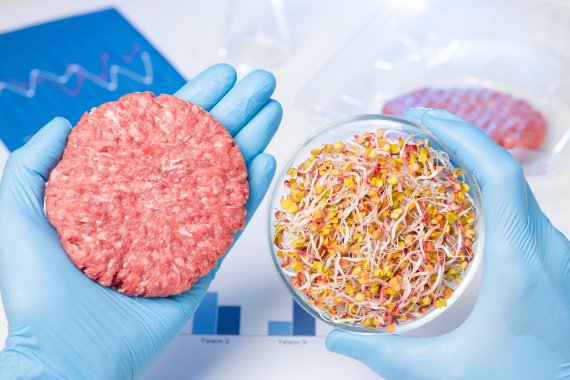People who want to cut down on meat are no longer condemned to spongy tofu chunks and tempeh. Whether you want smoked sausages or steak tartare, there is a vegetarian version of everything nowadays. That sounds healthy enough, but a lot of meat substitutes are high in salt, sugar and fat. Room for improvement? How, then?
Eat less meat and more plant-based food, is the Netherlands Nutrition Centre’s advice. It is better for the environment and for your health. The good news is that meat substitutes are usually high in protein. What is more, legumes such as soya lower your LDL cholesterol and therefore help to keep your blood vessels healthy. And yet research by the Nutrition Centre has often shown that meat substitutes contain too many saturated fats, and too much salt and sugar.
The Nutrition Centre has set an upper limit of 1.1 grams of salt per 100 grams of product. No product that exceeds that gets into the Wheel of Five, a pie chart widely used in the Netherlands to depict a healthy diet. It is not easy to cut down on the salt in meat substitutes, says Atze Jan van der Goot, professor of Protein Structuring and Sustainability at WUR. ‘Meat doesn’t not have much taste in itself. It gets its flavour from spices and from the Maillard reaction, which is what happens when sugars react with protein during the frying and roasting process, and is what creates a brown crust and savoury meaty flavour.’ It is difficult to get that effect when you fry meat substitutes, because they burn faster when fried at high temperatures. ‘That’s because plant proteins don’t hold moisture as well as animal proteins,’ explains Van der Goot. ‘There is less water to evaporate as they fry, so they burn more easily. We are researching ways of getting more water into meat substitutes so we can replicate the frying experience.’
If frying doesn’t work, producers have to find other ways of making the product tasty. Salt is a good flavour enhancer and covers up any unwanted flavours. Van der Goot: ‘Without a lot of salt and flavourings, that kind of product tastes of wheat, peas or soya. People don’t like that.’ A lot of salt is undesirable, though, because it is unhealthy. But the professor says it is difficult (i.e. expensive) to flavour the products with anything else.
‘The disadvantage is that plant proteins bind strongly to flavourings. We really want to research why that is. It is important because manufacturers currently have to add a lot of flavourings and they are expensive ingredients. Once we understand this better, we can be more focussed in our search for ways of giving plant-based products more flavour without a lot of salt. Besides enhancing flavour, salt helps give products structure, says Van der Goot. ‘Salt influences how proteins form networks. That is a reason why you add salt when baking bread. It’s not just for the flavour but also to get a firm dough and bread with good volume.’

Bacon
A third reason why meat substitutes contain salt has to do with the processing stages involved in extracting proteins from the raw materials such as peas and soya, explains Joeri Hollink, head of product development at vegetarian chicken producer Ojah. ‘With peas, you have to add acid to make proteins precipitate so you can extract them.’ To get rid of the acidity, producers of the raw material add sodium salt. So there is often 0.50 per cent of salt in the raw material. Hollink: ‘That might not sound like much, but if we want to sell products in the UK, for instance, they are not allowed to contain more than 0.63 per cent salt. So you reach that quite fast.’
But Hollink does think salt reduction is possible. ‘It depends on the product you are making too. Vegetarian bacon is on the high side, with two per cent salt, even though that’s quite low compared with bacon from pigs. We choose to give our products a fairly neutral taste, which is what chicken has too. Consumers can choose for themselves how to give it flavour.’
One way of reducing salt is to replace sodium chloride, kitchen salt, with other kinds such as potassium chloride. Unlike sodium, potassium lowers blood pressure, so it is healthier in that respect. Hollink: ‘The disadvantage is that it tastes bitter. You can replace about one third of the salt with potassium chloride before that taste starts to dominate.’
Along with salt, meat substitutes often contain too much saturated fat, according to the Nutrition Centre, which has set an upper limit of 2.5 grams of saturated fat per 100 grams. Meat products such as pork schnitzel or hamburgers are excluded from the Wheel of Five too. ‘Fat is important for the flavour and the smooth structure of products,’ says Van der Goot. ‘Consumers want the fat to run out when you put it in the pan and not before.’ To make sure the fat only runs out in the pan and not in the packaging, hard fats such as coconut or palm oil are used that stay solid at room temperature. These aren’t necessarily any less healthy, says Hollink: ‘If you use vegetable oil and heat it at high temperatures, you get unhealthy trans fats. That doesn’t happen when you heat coconut oil. So in that respect, it is better to use hard fats, especially if you are going to deep-fry the product.’
Sometimes extra sugar is added to meat substitutes, but usually in small quantities, says Hollink. ‘There used to be too much sugar in vegetarian products, added for flavour and so they would brown when fried. Nowadays, sugar levels have been reduced a lot. In our products we don’t use any sugar at all.’
Meat substitutes ≠ meat
A final criticism of meat substitutes is that they do not contain sufficient nutrients such as essential amino acids, vitamin B12 and iron. Is that a fair accusation, or do we just expect too much of meat substitutes? Professor of Protein Structuring Van der Goot: ‘The idea of meat substitutes is to entice people into cutting down on meat, not to replace it entirely. They were mainly designed for flexitarians so they can eat something other than meat now and then. So it is doubtful whether it’s desirable to put all the nutrients that are in meat into meat substitutes. Our diet consists of a range of foods, and meat substitutes don’t have to solve all the possible deficiencies. What is more, you can use meat substitutes to provide people with certain nutrients that they often don’t get enough of, such as fibre.’
Meat substitutes are mainly intended to make it easier for the consumer to eat less meat. ‘That is easiest if the alternative product is very like meat,’ says Van der Goot. He sees producers focusing on working on a wider choice of meat substitutes. ‘You could see that last year with the competition for the best vegetarian smoked sausage. And spreads for on bread are particularly popular in the Netherlands.’ Hollink agrees: ‘In health terms, our products are all right. What’s important to us is taste, sustainability and affordability. We are particularly interested in finding new ingredients, textures and taste experiences.’
To Van der Goot, it is important to think about the place of these meat substitutes in our diet, and what their nutritional value is. ‘For now, it is handy for them to resemble meat, to make the transition easy for consumers. Once people get used to the idea that protein-rich products don’t necessarily have to come from animals, there is scope for other kinds of products. Plant-based raw material is just not the same as animal raw material. Once we get away from the idea that meat substitutes must be like meat in nutritional value and structure, fewer processing stages will be necessary. You could then make products out of whole beans or peas, for instance, with all the valuable nutrients they contain.’

 Photo: Shutterstock
Photo: Shutterstock